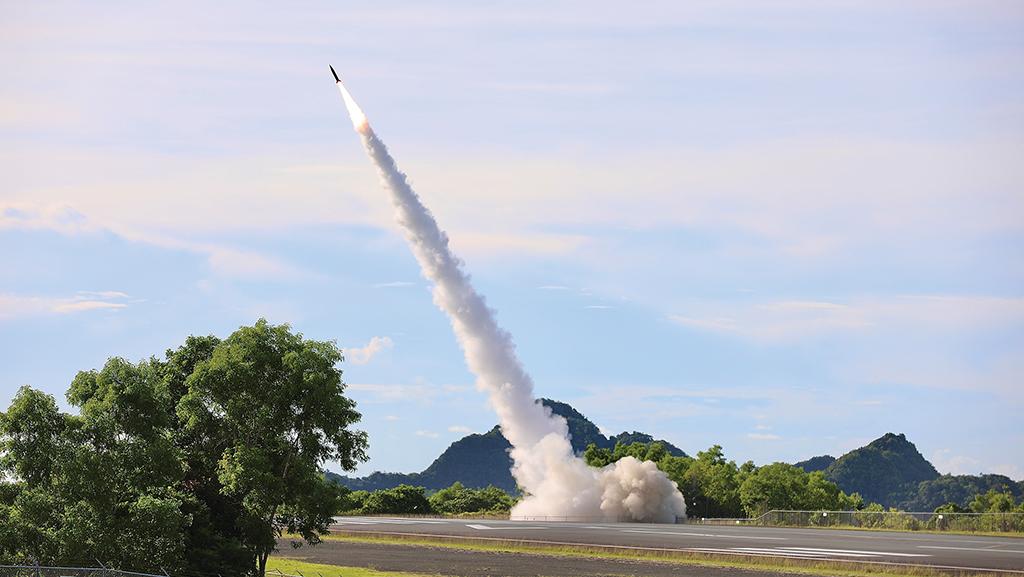This article is published in Aviation Week & Space Technology and is free to read until Aug 23, 2024. If you want to read more articles from this publication, please click the link to subscribe.
NATO Members Revive European Long-Range Strike Ambitions

The U.S. Army tested the Precision Strike Missile abroad in late June for the first time as part of the Valiant Shield 24 exercise in the Pacific.
In a sign of how relations between the West and Moscow have deteriorated, NATO members used their 75th-anniversary summit to push forward long-range strike capabilities to an extent not seen in Europe since the heights of the Cold War.
During the July 9-11 gathering in Washington, the White House said the U.S. Army intends to deploy hypersonic weapons and its Lockheed Martin Mid-Range Capability (MRC) to Germany in 2026 after the weapons enter operational service. Several European countries used the event to commit to joint development of a new long-range missile to fill critical capability gaps.
- U.S. sees “enduring stationing” of new missile capabilities in Europe
- France, Germany, Italy and Poland team on a European Long-Range Strike Approach
A joint statement from Berlin and Washington ahead of the summit announced that the U.S. will start episodic deployments in 2026 of the Army’s Multi-Domain Task Force (MDTF) long-range fires capabilities in Germany “as part of planning for enduring stationing of these capabilities.”
The MRC system, also known as Typhon, can fire Standard Missile 6s and Tomahawk cruise missiles. The joint statement also mentioned “developmental hypersonic weapons,” possibly referring to the Lockheed Martin Long-Range Hypersonic Weapon (LRHW), although it could also include in-development increments to the Army’s new ballistic Precision Strike Missile (PrSM). The LRHW, also called the Dark Eagle, has an unclassified range of at least 1,765 mi. The range of PrSM’s in-development Increment 4 is planned to exceed 1,000 km (621 mi).
Not since 1991 has the U.S. stationed long-range ground-launched cruise or ballistic missiles in Europe. The deployments this time will be of conventionally armed missiles, not nuclear ones, as during the Cold War. The Intermediate-Range Nuclear Forces Treaty signed by the U.S. and Soviet Union in 1987 stipulated that both countries eliminate missiles with ranges of 500-5,500 km, but the U.S. withdrew from the treaty in 2018 over Russian violations.
The U.S. Army established the 2nd MDTF at Clay Kaserne in Wiesbaden, Germany, in 2021. The unit initially included a headquarters element; an intelligence, cyberspace, electronic warfare and space detachment; and a brigade support company. An MDTF includes a strategic fires battalion comprising a battery each of an M142 High-Mobility Artillery Rocket System, an MRC and a Long-Range Hypersonic Weapon.
The Army deployed the MRC abroad for the first time in April, when it sent the 1st MDTF to the Philippines. In addition, the service tested the PrSM abroad for the first time in late June as part of the 3rd MDTF’s Valiant Shield 24 exercise across the Pacific.
The in-development LRHW includes a Lockheed Martin two-stage booster rocket as well as a Dynetics-produced hypersonic glide vehicle that is also slated for use in the U.S. Navy’s identical ship-based Conventional Prompt Strike system. The LRHW has suffered testing setbacks and has another test expected this summer. The Army aims to field the missile before year-end.
France, Germany, Italy and Poland signed a memorandum of understanding formulating the European Long-Range Strike Approach (ELSA) missile initiative on July 11. The effort “will allow the nations to develop, produce and supply capabilities in the field of long-range strikes,” the French government said. Germany’s defense ministry stated that the project illustrates Europe’s willingness to burden-share and strengthen its industrial base.
The agreement diverged slightly from previous official statements about the initiative. The German defense ministry said in June that ELSA would pursue missiles with a range greater than 1,000 km, but the July 11 memorandum halved that to greater than 500 km.
Moreover, Germany said in June that the initial agreement would comprise the “Weimar Triangle”—France, Germany and Poland—with Italy, Spain and the UK likely to join later. But Italy has also signed up for the initial agreement.
None of the governments have offered details about the funding, schedule or scope of the new program.
The ELSA effort represents Europe’s long-deferred answer to developments by Russia and the U.S. in long-range strike. Russia has fielded several ground-launched weapons with a range greater than 500 km, including the Iskander short-range ballistic missile and the Novator 9M729 cruise missile.
European missile manufacturer MBDA in June proposed development of a ground-launched conventional deep-strike cruise missile based on its existing MdCN naval cruise missile. The company said that because the missile is already developed, it would just need to produce a vehicle-based launcher and adapt or manufacture a mission planning system.
“The idea is that it will pose a permanent threat to an adversary and their high-value assets,” Pierre Marie-Belleau, product lead for MBDA’s deep-strike product portfolio, told Aviation Week in June.
MBDA says the missile would be highly survivable, thanks to an already low radar cross-section that can be further improved, as well as its range and low cost compared with long-range ballistic missiles.
France has also been developing new air- and submarine-launched hypersonic weapons, including the ArianeGroup’s air-launched, nuclear-tipped ASN4G cruise missile and V-Max glide vehicle demonstrator.
Germany has been ramping up investment in long-range strike, too, greenlighting a program with Norway to develop the 3SM Tyrfing supersonic, long-range cruise missile. The governments in July awarded Norway’s Kongsberg, partnered with MBDA and Diehl, a development program for the ship-based missile.
European weapons development efforts gained momentum after Russia’s 2022 full-scale invasion of Ukraine. NATO members also disclosed at the summit that the transfer of Lockheed Martin F-16s to Ukraine was starting to help the embattled country defend itself.
Germany, Italy and the Netherlands also announced a $700 million joint purchase of 940 Stinger Block 1 missiles from RTX through a U.S. Foreign Military Sale arranged by NATO’s Support and Procurement Agency.







